Introduction
The issues related with crime evaluation have for a long time blamed the victims for the crimes perpetrated against them.
Greater efforts and resources were focused on the criminal offenders, for instance through rehabilitation, while the victims languished in blame.
Consequently, developments have enhanced the change of thought in relation to the concept of victim through the creation of support mechanisms.
The dynamic change from the researches on victim characteristics shifted to the development of victim assisted programs, problem solving courts and responsive justice.
The aim of crime evaluation and police departments is to guarantee safety for the people living in the neighborhoods.
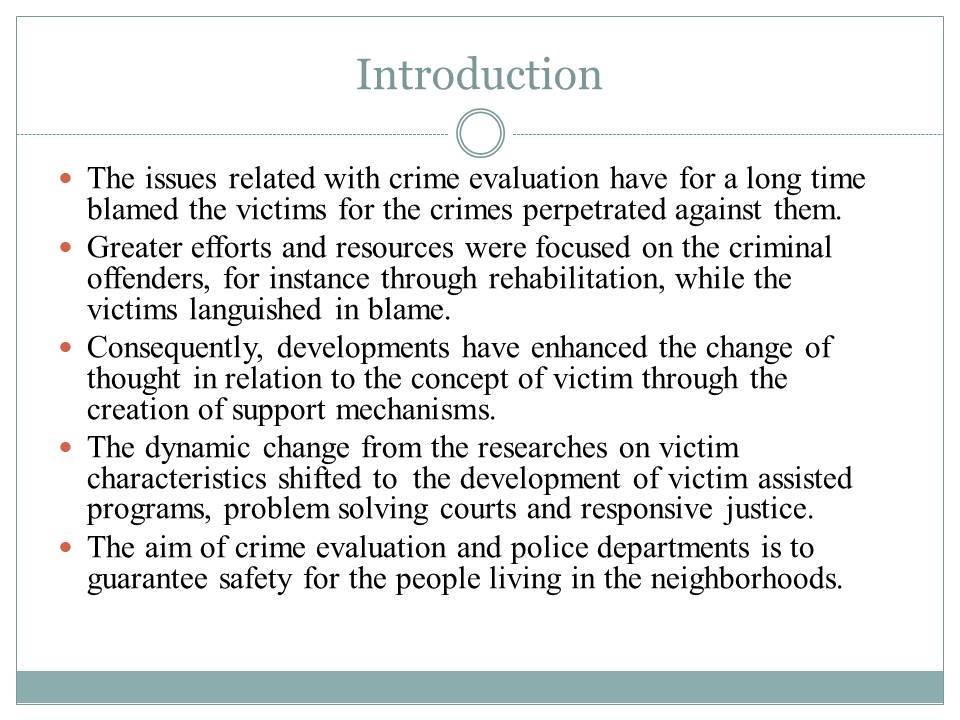
Concept of Victim
The victim concept dates back in history to the earlier years when it was related to the concept of sacrifice.
The foundation of victiminology in the 1940s described victims as the instigators of their own personal victimizations. Victiminology explored the victim’s characteristics and tried to gain an explanation of how they contributed to their victimization (Ziegenhagen, 2007).
The 1960s saw the coming back of the golden age where victims had well-recognized rights and systems to help them.
The victim concept thus went beyond the implications of an injured party’s existence or the elusion of compassion from other people.
Ziegenhagen (2007) argues that victims are targets for victimization by the professional criminals. They are also information sources to the police, and cause of their victimization to the people. For example victims of crimes such as robbery or gang violence are likely to be blamed for the crime.
Despite the complexity of the concept, research has identified the risk factors of victims and the establishment of victim assisted programs to counsel, compensate and help victims overcome the effects of victimization (Newmark, Smith, Bonderman & Liner, 2003).
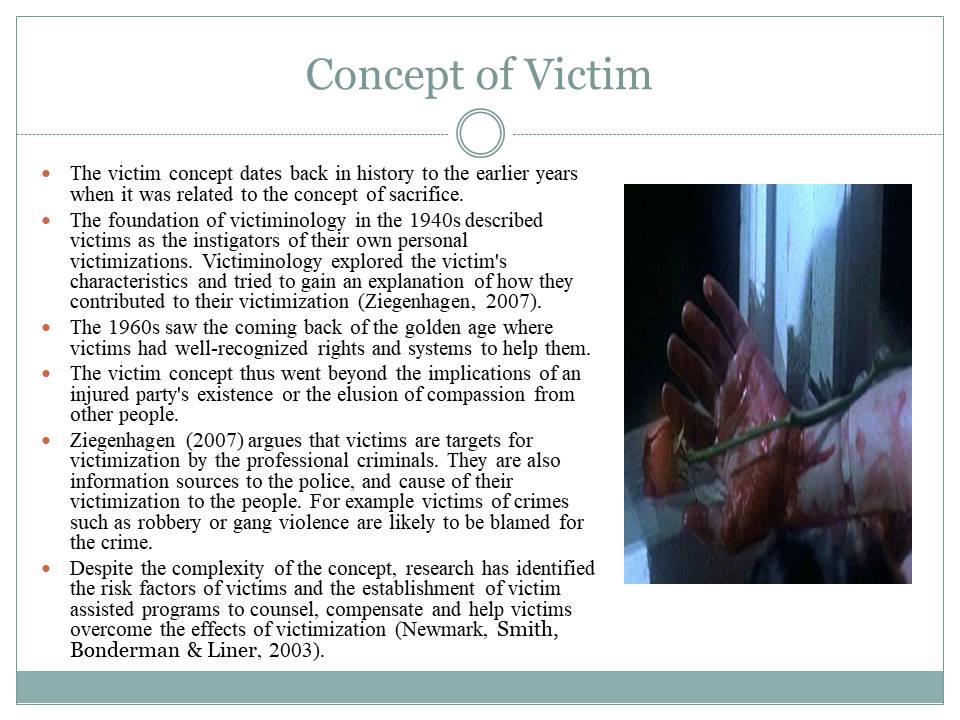
History & Significance of VAPS
The VAPS begun as a response by organizations that worked with criminal offenders in the 1960s.
It was noted that the corrective measures put in place did not provide mechanisms that allowed offenders to take responsibility for their actions. Instead, focus was on what the society had done to the offenders that caused them to act with no public or victim concern.
VAPS begun as advocates for the victims in early 1972. The program initiators addressed welfare forums and offered victim services by 1976. The program was founded on grounds of social sciences and welfare with the establishment of victim rights, policies and programs.
Research was encouraged especially in the area of risk factors surrounding the victim.
The main role of VAPs is to help victims of crime by offering services such as counseling, compensation, reassurance and other practical, information and social support (National Victims Assistance Consortium Standards, 2003).
VAPs facilitate the effective promotion of justice in increasing the range and availability of services to crime victims from the point of crime and throughout the healing process. These include the forums of justice such as courts and other authorities such as schools (NVASC, 2003). For example, schools can serve to ensure that victims are taken care of by launching campaigns to stop crimes such as knife crimes or even expelling students found to be offenders.
VAPs are also significant in increasing the network and coordination of groups, agencies and organizations to fully and positively impact the victims. Further, they seek to increase the public knowledge on victimization and its impact so that they can form support networks among communities and neighborhoods (NVASC, 2003).
VAPS are significant in victim legislation with evidence of the establishment of crime victims compensation and federal office of victims of crime (OVC) through the 1984 federal Victims of Crime Act (VOCA).
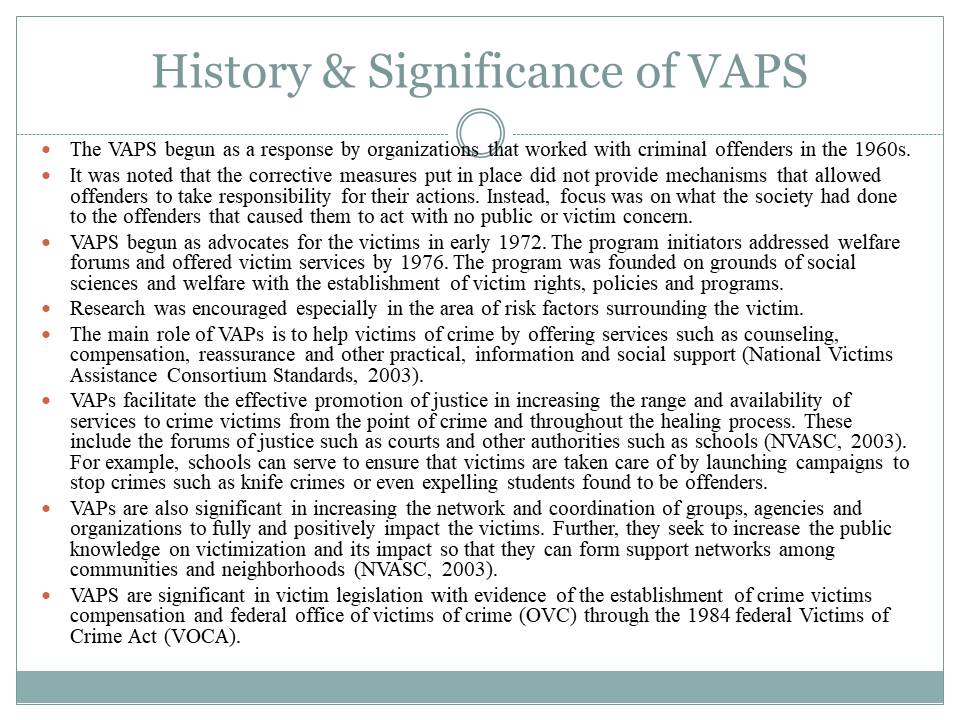
Functions of VAPS with Reference to Criminal Justice System
The victims of crime are crucial to the criminal justice system and thus it is the responsibility of VAPs to enable them be informed about their rights especially the Crime Victims Act (Victims Committee, 2006).
VAPs have the responsibility of seeking the improvement of the status of crime victims in the criminal justice system.
VAPs help to expand the opportunities of victims participating in the criminal justice system. They have to ensure that the victims are informed, present and heard throughout the process of justice (NVASC, 2003).
Further, they have the responsibility of increasing the commitment of the state, federal, and local governments, non-profit organizations and faith-based organizations towards the provision of services, funding, response mechanisms and other treatment forums for victims of crime (Victims Committee, 2006). An example is the setting up of hospitals that cater for the treatment of rape victims to avoid adverse events such as infections or unwanted pregnancy.
VAPs are responsible for advancing the victims’ rights by improving the criminal justice system through representation by attorneys and other legislators (Victims Committee, 2006).
VAPs have increased the rights of the victims. For example, victims are given the mandate of conferring with their prosecutors before and even during the process of plea negotiations (Victims Committee, 2006).
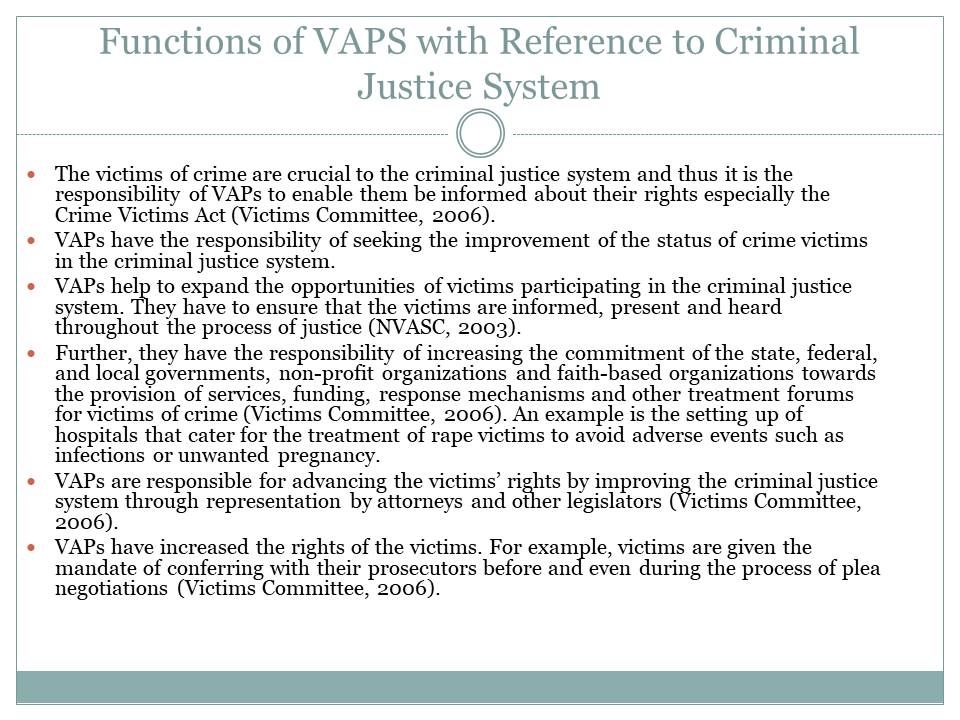
Problem Solving Courts and Restorative Justice
A problem solving court (PSC) is mandated to use the court authority to address the problems underlying in individual litigation system of justice and other social problems (Freiberg, 2008).
There are different models of these courts which include community courts, domestic violence courts, drug courts and mental health courts (Casey & Rottman, 2009).
Casey & Rottman (2009) suggest that the expected trends of problem solving courts include stabilization and sustainability, setting of realistic expectations, sharing of information increasing, increased disclosure of ethical and legal issues and increased in public support.
Restorative justice begun as an alternative model of criminal justice since it sought to bring reconciliation and healing for victims, offenders and communities and is supported by restitution.
Restorative justice through restitution also helps victims recoup some part of their victimization cost, for example, the costs incurred in treating a physically wounded victim. The aim is to establish balance between the needs of the victim, community and the offender.
Menkel-Meadow (2007) argues that restorative justice is located in juvenile delinquency, problem solving courts, family mediation and other victim assisted programs and mainly encompasses the issues of reintegration, acceptance of responsibility, justice, truth and reconciliation, and creation of sentence and healing through transformation of communities and neighborhoods.
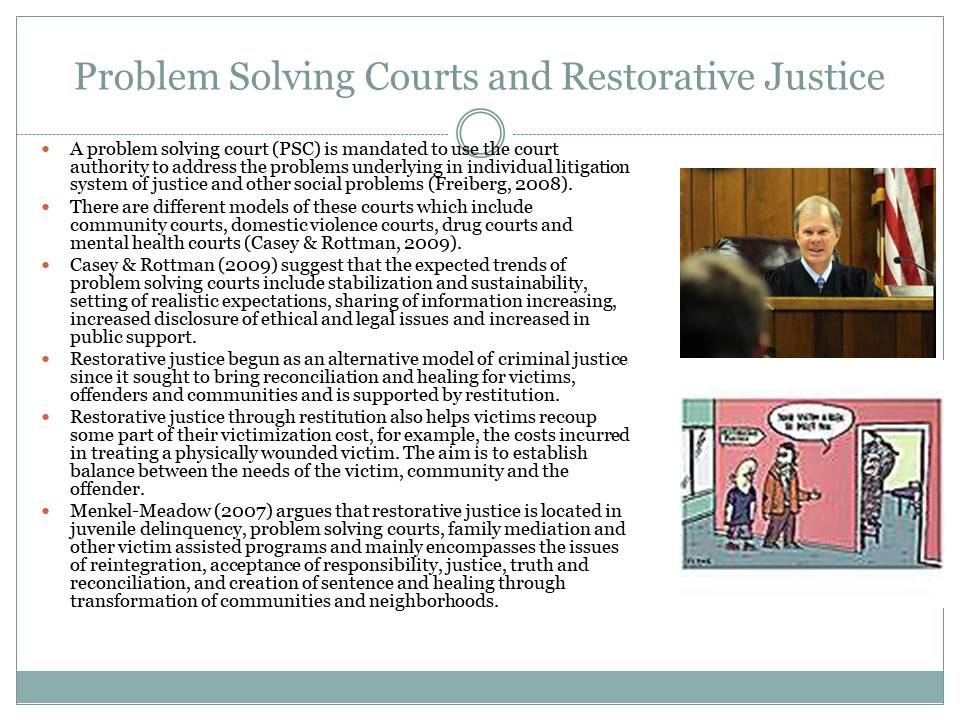
Conclusion
This paper has focused on victims and crime evaluation.
The concept of victim has been explored and reviewed.
The issues of victim assisted programs have been evaluated with the history, significance and the purposes of their functions with reference to the criminal justice system.
Further, the concepts of problem solving courts and restorative justice have been evaluated and illustrated through examples and trends.
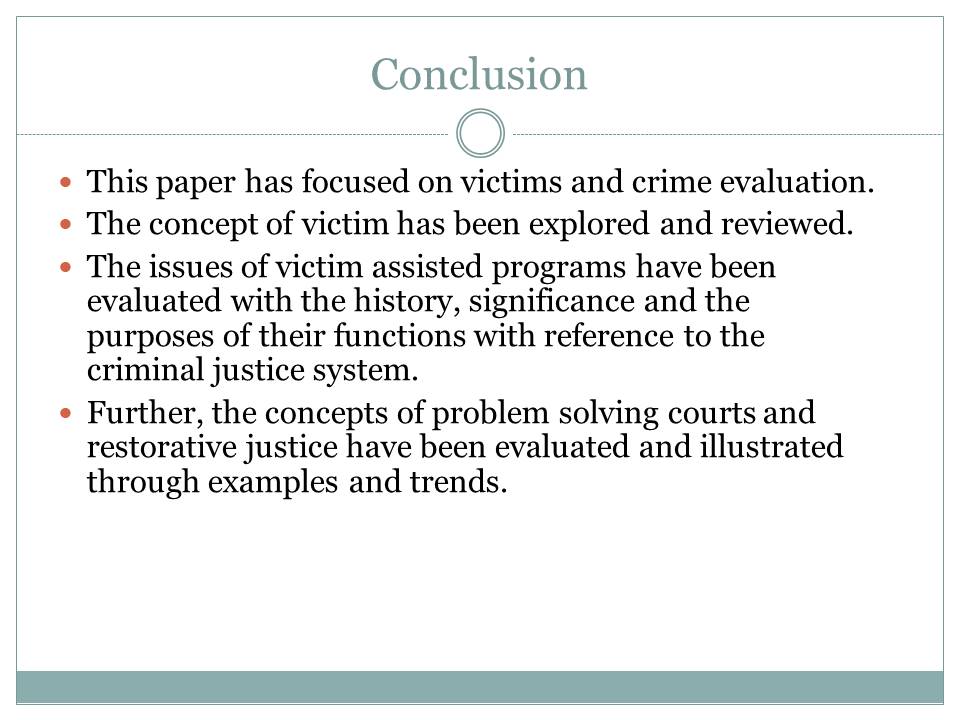
Reference List
Casey, P., & Rottman, B. (2009). Problem Solving Courts: models and trends. Web.
Freiberg, A. (2008). The theory and practice of problem solving courts: Does it stack up? Web.
Menkel-Meadow, C. (2007). Restorative justice: What is it & does it work? Annual Review of Law and Social Science, 3, 161-187.
National Victims Assistance Consortium Standards. (2003). Standards for victim assistance programs and providers. California: University of South California.
Newmark, L., Smith, B., Bonderman, J., & Liner, B. (2003). The national evaluation of state victims of crime act assistance and compensation programs: trends and strategies for the future. Web.
Victims Committee. (2006). The victim in the criminal justice system. Web.
Ziegenhagen, A. (2007). Criminal victim.